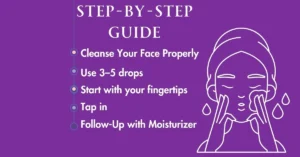Dry skin can be a real pain, right? It feels tight, flaky, and sometimes even a little itchy. If you’ve tried countless store-bought creams with little success, don’t worry—there’s a simpler solution that’s both easy on the wallet and much more natural: homemade face serum. Making your own serum at home is not only effective, but it also allows you to customize it to your skin’s exact needs. Let’s dive in and get your glow back!
Why Choose a Homemade Face Serum?
Face serums are great for hydrating dry skin. They’re light, absorb quickly, and pack a punch with active ingredients. But store-bought serums can be expensive and, let’s face it, filled with chemicals you probably don’t want on your skin. That’s where making your own serum comes in. You can use fresh, natural ingredients, avoid harsh chemicals, and customize it to address your skin’s specific needs. Plus, it’s a lot easier than it sounds.
Understanding Dry Skin
Before we jump into making the serum, let’s take a quick minute to understand what dry skin is and how it behaves.
Dry skin happens when your skin lacks moisture. It can feel tight, rough, or even itchy. The outer layer of your skin, called the epidermis, may not be holding onto moisture as it should. Dry skin can also appear flaky or dull, and sometimes, it’s just a matter of genetics or the weather (like the harsh winter winds or dry indoor heat).
It’s important to know that dry skin is different from dehydrated skin. Dehydrated skin lacks water, while dry skin lacks oils. Both need hydration, but the approach to fixing them is slightly different. When it comes to dry skin, you need ingredients that help lock in moisture and restore the skin’s natural oils.
Key Ingredients for Your Homemade Face Serum
The beauty of making a DIY serum is you can handpick each ingredient based on your needs. So, what goes into a good face serum for dry skin?
1. Hydrating Oils

Oils are crucial when you’re dealing with dry skin. But not just any oil will do. Some oils hydrate better than others.
- Jojoba Oil: Closest to our skin’s natural oils, it helps balance moisture and won’t clog pores.
- Argan Oil: Packed with vitamin E, it nourishes and adds a healthy glow.
- Rosehip Oil: Known for its ability to help with skin regeneration and healing, this oil is a great choice if your dry skin is also showing signs of aging or scarring.
- Almond Oil: Soothes and deeply hydrates, helping to improve the skin’s texture.
2. Humectants

Humectants pull moisture from the air into your skin. Think of them like magnets for water!
- Hyaluronic Acid: One of the most powerful humectants. It can hold 1000 times its weight in water, making it a super hydrator for dry skin.
- Glycerin: A natural humectant, glycerin draws moisture from the environment to keep skin plump and hydrated.
- Aloe Vera: Known for its soothing and moisturizing properties, aloe vera is great if your dry skin is irritated.
3. Antioxidants
These help repair the skin and fight free radicals that cause skin damage.
- Vitamin E: It helps reduce inflammation and is fantastic for healing and moisturizing the skin.
- Green Tea Extract: This antioxidant is known for its anti-inflammatory properties and helps protect skin from environmental damage.
4. Essential Oils
Essential oils don’t just smell great—they can also work wonders for dry skin. But remember, a little goes a long way with these powerful oils.
- Lavender: Soothes and calms the skin, perfect if your dry skin is irritated.
- Geranium: Known for its balancing properties, it can help restore moisture and calm inflammation.
- Sandalwood: A hydrating oil that also helps with skin renewal.
5. Carrier Oils
Carrier oils are the base oils that dilute essential oils and make them safe to apply to the skin.
- Coconut Oil: A fantastic moisturizer that helps restore the skin’s natural oils.
- Olive Oil: Rich in antioxidants, it’s a great choice for dry skin that needs a bit of extra TLC.
Benefits of Homemade Face Serum for Dry Skin
So, why go through the trouble of making your own face serum? Let’s break down the benefits:
- Personalization: You can mix and match ingredients based on what your skin needs most, whether it’s more hydration, anti-aging properties, or calming relief from irritation.
- No Harsh Chemicals: Store-bought serums often come with added preservatives, chemicals, and fragrances. By making your own serum, you’re skipping all that.
- Cost-Effective: High-quality skincare can be pricey. But making your own serum at home costs a fraction of what you’d pay for a bottle of the commercial stuff.
- Better for Your Skin: You control the quality of the ingredients, so you know exactly what’s going onto your face.
How to Make Your Own Face Serum for Dry Skin (Step-by-Step)
Now, let’s get to the fun part: making the serum! Don’t worry, it’s super easy.
Step 1: Choose Your Base Oil
Start with a base oil. You’ll need about 2 tablespoons. Jojoba oil is a solid choice for most skin types, but if you’ve got super dry skin, go for something heavier like rosehip or almond oil.
Step 2: Add Hydrating and Repairing Ingredients
Now, let’s add some serious moisture and skin-loving ingredients:
- Hyaluronic Acid (optional, but highly recommended): Add 2-3 drops to your serum mix. This will pull in moisture and keep your skin looking plump.
- Vitamin E Oil: Add about 5 drops. This will help heal and protect your skin.
Step 3: Mix and Blend
Grab a small glass dropper bottle (preferably dark glass, so it preserves the potency of your oils). Add all your ingredients and shake well. It’s a good idea to test the serum on your wrist before using it on your face to make sure you don’t have any allergic reactions.
Step 4: Store and Use
Store your serum in a cool, dark place, and it should last for about 1-2 months. To use it, simply apply a few drops to clean, damp skin after cleansing and toning. Gently massage it in with upward strokes. You can use it twice a day, morning and night.
Note: If you don’t like this pera (I mean don’t love to make facial serum at your home 😂) then choose a good facial serum with Multiple choices… Just Kidding 🙂 .
Recommended DIY Face Serum Recipes for Dry Skin
Here are a few easy recipes to get you started:
1. Hydrating Rosehip and Argan Oil Serum
- 1 tablespoon rosehip oil
- 1 tablespoon argan oil
- 3 drops lavender essential oil
This blend is soothing and hydrating, perfect for dry, irritated skin.
2. Aloe Vera and Lavender Essential Oil Serum
- 1 tablespoon aloe vera gel
- 1 tablespoon jojoba oil
- 2 drops lavender essential oil
A calming and moisturizing serum for sensitive skin.
3. Vitamin E and Jojoba Oil Repair Serum
- 2 tablespoons jojoba oil
- 3 drops vitamin E oil
- 2 drops sandalwood essential oil
A healing serum that helps restore moisture and fight signs of aging.
4. Avocado Oil and Honey Serum
- 1 tablespoon avocado oil
- 1 teaspoon honey
- 3 drops of geranium essential oil
This recipe provides deep hydration and nourishment, ideal for super dry skin.
Tips to Customize Your Serum
Feel free to get creative and customize your serum to target your specific skin concerns:
- For Fine Lines: Add a few drops of frankincense or carrot seed oil. These essential oils have anti-aging properties that help promote skin elasticity.
- For Extra Moisture: Use avocado oil or sweet almond oil, both of which are fantastic for locking in moisture.
- For Sensitive Skin: Try using chamomile or lavender essential oil to calm and soothe irritation.
How to Apply Your DIY Face Serum
You’ve made your serum—now it’s time to use it properly.
- Cleanse and Tone: Wash your face with a gentle cleanser and apply a toner to balance the skin’s pH.
- Apply Serum: Use 2-3 drops of serum and gently massage it into your face in upward motions.
- Moisturize: If needed, follow up with a moisturizer to seal in the serum.
Common Mistakes to Avoid
Making your own serum is simple, but there are a few things you’ll want to watch out for:
- Using Too Many Oils: Less is more. Too many oils can leave your skin feeling greasy, and some may even clog your pores.
- Not Diluting Essential Oils: Essential oils are potent. Always dilute them with a carrier oil to avoid irritation.
- Skipping Patch Tests: Always patch test your serum before applying it to your face, especially if you have sensitive skin.
How to Maintain Healthy, Hydrated Skin Beyond the Serum
Making a homemade face serum is just one part of the equation. Here are a few extra tips to keep your skin healthy and hydrated:
- Drink Water: Stay hydrated by drinking plenty of water throughout the day.
- Use a Humidifier: If you live in a dry climate, a humidifier can help prevent your skin from getting too dry.
- Eat Hydrating Foods: Include omega-3 fatty acids and antioxidants in your diet (think avocados, nuts, and berries) to support skin health.
Final tought
Making your own face serum for dry skin is a game-changer. It’s simple, cost-effective, and gives you control over the ingredients that touch your skin. With just a few natural ingredients, you can create a serum that keeps your skin hydrated, glowing, and healthy. Don’t be afraid to experiment and find the perfect blend for your skin. Remember, natural skincare takes time to show results, but with a little patience, you’ll see the benefits soon enough. Happy DIY-ing!


